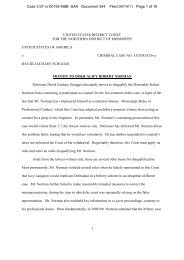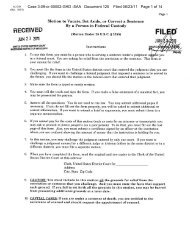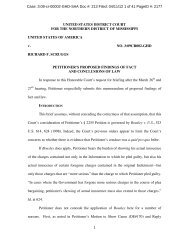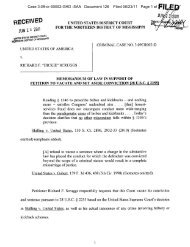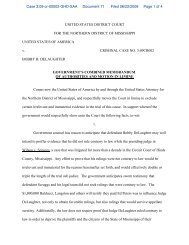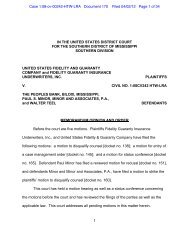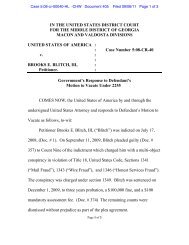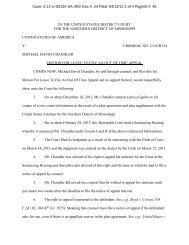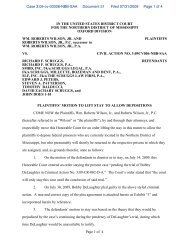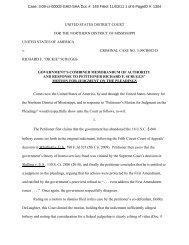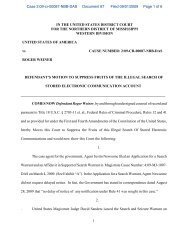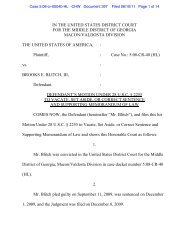Scruggs motion for a judgment on the pleadings - NMissCommentor
Scruggs motion for a judgment on the pleadings - NMissCommentor
Scruggs motion for a judgment on the pleadings - NMissCommentor
You also want an ePaper? Increase the reach of your titles
YUMPU automatically turns print PDFs into web optimized ePapers that Google loves.
!aaassseee::: 333:::000999---cccrrr---000000000000222---GGGHHHDDD---SSSAAAAAA DDDoooccc ###::: 111444555 FFFiiillleeeddd::: 111000///111777///111111 555 ooofff 999 PPPaaagggeeeIIIDDD ###::: 111222999444<br />
used in disclaimers. Public Citizen Inc. v. Louisiana Attorney Disciplinary Bd., 632<br />
F.3d 212 (5 th Cir., 2011).<br />
At least Louisiana’s rules were quite explicit about what was and was not<br />
prohibited, unlike <strong>the</strong> facially vague statute that <strong>the</strong> Government is trying to use<br />
here. See SEIU Local 5 v. City of Houst<strong>on</strong>, 595F.3d588(5 th Cir.,2010) (striking<br />
down ordinances holding that, “regulati<strong>on</strong> of speech must be through laws whose<br />
prohibiti<strong>on</strong>s are clear.”) The h<strong>on</strong>est services fraud statute obviously is not clear, as<br />
evinced by <strong>the</strong> Government own inability to c<strong>on</strong>sistently specify its scope. 2<br />
For <strong>the</strong> purposes of a First Amendment overbreadth challenge, in c<strong>on</strong>trast to<br />
a Due Process vagueness challenge as in Skilling, it does not matter whe<strong>the</strong>r<br />
Petiti<strong>on</strong>er’s own case could be c<strong>on</strong>stituti<strong>on</strong>ally prosecuted. The First Amendment<br />
c<strong>on</strong>text creates even greater c<strong>on</strong>cerns about fair notice, <strong>the</strong> chilling of speech, and<br />
discriminatory en<str<strong>on</strong>g>for</str<strong>on</strong>g>cement. See U.S. v. Stevens, 130 S.Ct. 1577, 1587 (2010)<br />
(striking down an overbroad statute, without determining whe<strong>the</strong>r applicati<strong>on</strong> to<br />
<strong>the</strong> criminal defendant would have been c<strong>on</strong>stituti<strong>on</strong>al.). 3 Arguably, <strong>the</strong> defendant<br />
in Stevens should have known that his behavior, involving videotaping <strong>the</strong> crushing<br />
of small animals, was wr<strong>on</strong>gful, but <strong>the</strong> statute was struck down n<strong>on</strong>e<strong>the</strong>less. The<br />
mere fact that <strong>the</strong> h<strong>on</strong>est services fraud statute is vague prevents it from being<br />
2 Compare Brief <str<strong>on</strong>g>for</str<strong>on</strong>g> <strong>the</strong> United States Government in Weyhrauch v. U.S., 2009WL3495337,45-46<br />
(“H<strong>on</strong>est-services fraud does not embrace allegati<strong>on</strong>s that purely political interests may have influenced a public<br />
official’s per<str<strong>on</strong>g>for</str<strong>on</strong>g>mance of his duty. The core interests that give rise to <strong>the</strong> divided loyalties covered are pers<strong>on</strong>al<br />
financial interests of <strong>the</strong> official, his family, or his associates that raise a c<strong>on</strong>flict with official duties.”) and its<br />
Resp<strong>on</strong>se in this case (arguing that a n<strong>on</strong>-financial political endorsement could <str<strong>on</strong>g>for</str<strong>on</strong>g>m <strong>the</strong> basis <str<strong>on</strong>g>for</str<strong>on</strong>g> h<strong>on</strong>est services<br />
fraud) .<br />
3 See Board of Trustees of State Univ. of N.Y. v. Fox, 492 U.S. 469, 483, 109 S.Ct. 3028, 106 L.Ed.2d 388<br />
(1989) (“Ordinarily, <strong>the</strong> principal advantage of <strong>the</strong> overbreadth doctrine <str<strong>on</strong>g>for</str<strong>on</strong>g> a litigant is that it enables him to benefit<br />
from <strong>the</strong> statute's unlawful applicati<strong>on</strong> to some<strong>on</strong>e else ”); see also Ohralik v. Ohio State Bar Assn., 436 U.S. 447,<br />
462, n. 20, 98 S.Ct. 1912, 56 L.Ed.2d 444 (1978) (describing <strong>the</strong> doctrine as <strong>on</strong>e “under which a pers<strong>on</strong> may<br />
challenge a statute that infringes protected speech even if <strong>the</strong> statute c<strong>on</strong>stituti<strong>on</strong>ally might be applied to him”).<br />
5



